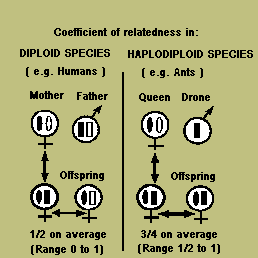
Isoptera (Termites)
Homoptera (aphids, recently discovered)
Mammals (naked mole rats)
Tinbergen's 4 questions: 1. Function 2. Causation 3.Ontogeny
4.Phylogeny
A fossil record prediction of evolution: general increase in species number and diversity.
Theory of Evolution by Natural selection:
1. mutation (= variation). 2. Selection with the inclusion of
Mendel's work/genetics => Neo-Darwinism
It assumes genetic basis to behaviour, i.e. that behavioural differences individuals are caused by differences in genotypes (see bk.1 p.59... for examples) but this does not imply that there is a simple one- to-one correspondence between a gene and a behaviour or that organisms are slaves to their genes. Phenotypes are the products of genotypes and the environment.
Natural selection alters genotypes via its action on phenotypes.
Fitness is a measure of Lifetime Reproductive Success (LRS) which is defined as the number of fertile offspring that an animal produces during its lifetime and that survives to breed themselves.
Fitness is a relative measure (i.e. compared to that of other
competing individuals in the rest of the population). Natural
selection is therefore not a black & white phenomenon.
Individual selection. The process by which a behaviour is favoured (by natural selection) due to its beneficial effects on the production of offspring.
BEWARE of the fallacious (but frequently used) group selection argument that animals behave for the good of the group/species. Group selection cannot work because, among other things, cheaters will always benefit. Natural selection is blind (it has no foresight) and acts at the level of the individual, with no regard for the future of the species. But what about altruism?
Kin selection: (inclusive fitness). The process by which a behaviour is favoured due to its beneficial
effects on the production of relatives (siblings, cousins etc. as well as offspring). Although the definition includes offspring, in practise (and regrettably because it makes it sound like a different phenomenon) kin selection is invoked for its effect on relatives other than offspring.
Altruism viewed as genetic selfishness (selfish gene): since relatives share genes, helping them is a bit like helping yourself.
General prediction: the more related, the more altruistic
The case of extreme altruism: suicide and reproductive altruism in eusocial insects.
Characteristics of Eusociality (meaning perfectly social):
Eusociality is found in three orders of insects, and one species of mammals:
Hymenoptera (ants, bees, wasps) where it evolved 11 times independently!

Isoptera (Termites)
Homoptera (aphids, recently discovered)
Mammals (naked mole rats)